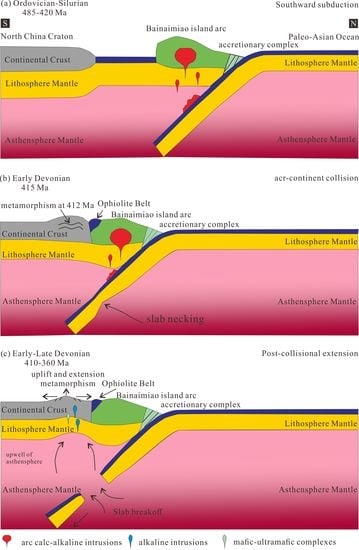Early-Late Devonian Post-Collision Extension Due to Slab Breakoff Regime along the Northern Margin of North China Craton: Implications from Muscovite 40Ar-39Ar Dating
Abstract
1. Introduction
2. Geological Background
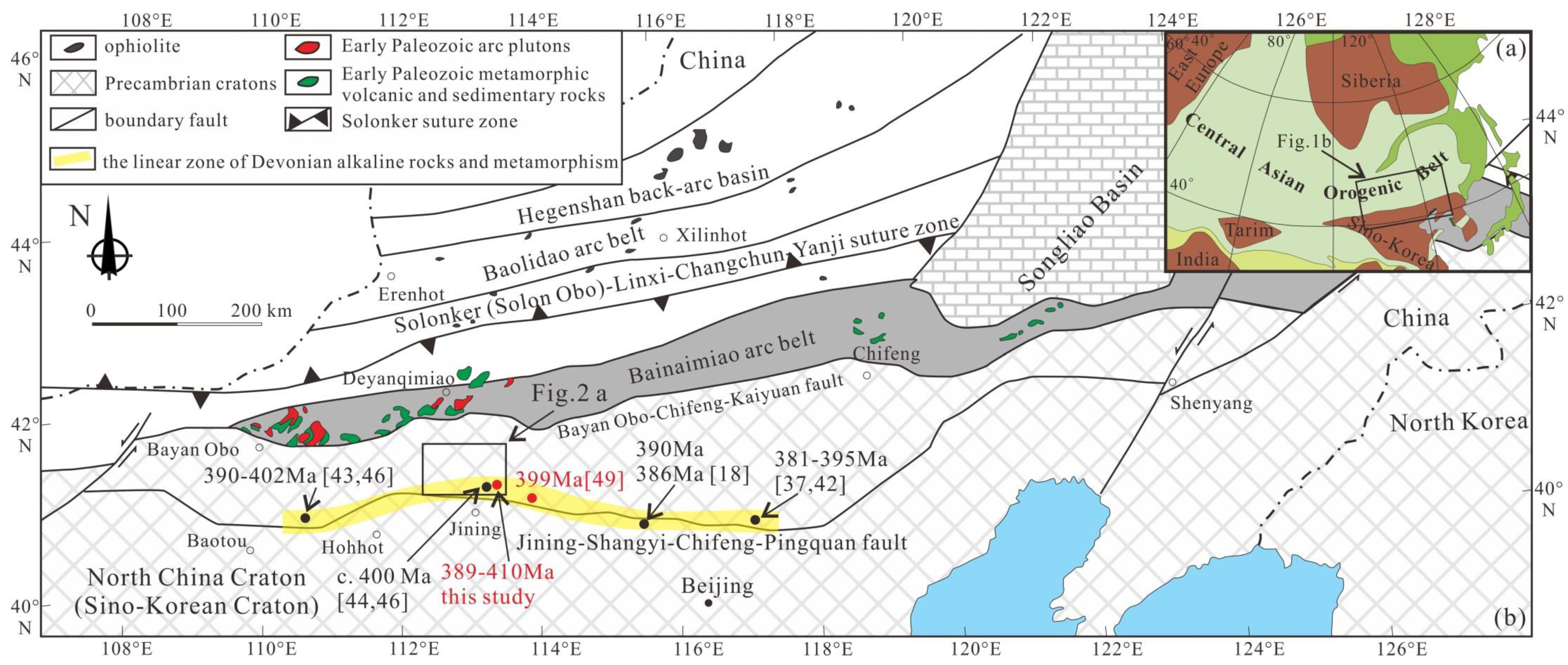
| Location | Latitude | Longitude | Rocktype | Age (Ma) | Method | Ref. |
|---|---|---|---|---|---|---|
| Zircon U-Pb ages of the Early Paleozoic rocks in Bainaimiao arc | ||||||
| Deyanqimiao | 42°25′42″ | 113°07′47″ | Amphibolite | 490 ± 5 | SHRIMP | [25] |
| Tulinkai | - | - | Quartz diorite | 467 ± 13 | SHRIMP | [26] |
| Tulinkai | - | - | Dacite | 459 ± 8 | SHRIMP | [26] |
| Tulinkai | - | - | Trondhjemite | 451 ± 7 | SHRIMP | [26] |
| Tulinkai | - | - | Anorthosite | 429 ± 7 | SHRIMP | [26] |
| Bainaimiao | - | - | Granitic porphyry | 440 ± 40 | Sm-Nd | [27] |
| Chaganhushao | - | - | Granodiorite | 430 ± 13 | Zircon U-Pb | [28] |
| Bayan Obo | - | - | Diorite | 447–493 | Zircon U-Pb | [29] |
| Damaoqi | 41°55′54″ | 110°7′18″ | Diorite | 452 ± 3 | SHRIMP | [30] |
| Damaoqi | 41°59′12″ | 110°6′54″ | Diorite | 440 ± 2 | SHRIMP | [30] |
| Damaoqi | 41°59′12″ | 110°6′54″ | Quartz diorite | 446 ± 2 | SHRIMP | [30] |
| Damaoqi | 41°55′6″ | 110°7′12″ | Granodiorite | 440 ± 2 | SHRIMP | [30] |
| Zircon U-Pb ages of Devonian magmatic rocks and Ar-Ar ages of Devonian metamorphism | ||||||
| Baicaigou | 40°56′17″ | 110°32′54″ | Monzonite | 395 ± 3 | LA-ICP-MS | [46] |
| Baicaigou | 40°56′47″ | 110°32′48″ | Monzogranite | 402 ± 2 | LA-ICP-MS | [46] |
| Baicaigou | 40°55′55″ | 110°34′47″ | Monzogranite | 402 ± 2 | LA-ICP-MS | [46] |
| Baicaigou | 40°55′44″ | 110°34′46″ | Monzogranite | 399 ± 3 | LA-ICP-MS | [46] |
| Gaojiacun | - | - | Hornblende syenite | 390 ± 5 | TIMS | [43] |
| Gaojiacun | 41°01′34″ | 110°31′50″ | Hornblende syenite | 399 ± 7 | SHRIMP | [43] |
| Gaojiacun | 41°02′35″ | 110°25′17″ | Hornblende syenite | 396 ± 2 | LA-ICP-MS | [46] |
| Sandaogou | - | - | Quartz monzonite | 409 ± 2 | LA-ICP-MS | [20] |
| Sandaogou | - | - | Pyroxene syenite | 408 ± 4 | LA-ICP-MS | [20] |
| Sandaogou | 41°33′23″ | 112°53′30″ | Pyroxene syenite | 401 ± 2 | LA-ICP-MS | [46] |
| Shangdu | 41°34′46″ | 112°54′50″ | Syenite | 411 ± 1 | LA-ICP-MS | [44] |
| Sandaogou | 41°32′59″ | 112°57′42″ | Monzonite | 401 ± 1 | LA-ICP-MS | [46] |
| Sandaogou | 41°32′59″ | 112°57′42″ | Gabbro | 399 ± 1 | LA-ICP-MS | [46] |
| Sandaogou | 41°32′59″ | 112°57′42″ | Pyroxenite | 398 ± 2 | LA-ICP-MS | [46] |
| Wulanhada | - | - | Quartz monzonite | 382 ± 4 | SHRIMP | [45] |
| Wulanhada | 41°35′49″ | 113°08′18″ | Monzonite | 381 ± 2 | LA-ICP-MS | [46] |
| Wulanhada | 41°35′33″ | 113°10′28″ | Monzonite | 379 ± 1 | LA-ICP-MS | [46] |
| Wulanhada | 41°35′33″ | 113°10′28″ | Gabbro | 377 ± 1 | LA-ICP-MS | [46] |
| Wulanhada | 41°35′33″ | 113°10′28″ | Pyroxenite | 381 ± 5 | LA-ICP-MS | [46] |
| Shuiquangou | - | - | Quartz monzonite | 390 ± 6 | SHRIMP | [18] |
| Shuiquangou | - | - | Syenite | 386 ± 7 | SHRIMP | [18] |
| Hongshila | 41°10′17″ | 117°15′58″ | Pyroxenite | 394 ± 4 | LA-ICP-MS | [42] |
| Hongshila | 41°10′13″ | 117°15′52″ | Pyroxenite | 381 ± 7 | SHRIMP | [42] |
| Hongshila | 42°10′03″ | 117°16′11″ | Pyroxenite | 387 ± 2 | LA-ICP-MS | [42] |
| Erdaogou | 41°08′18″ | 117°38′15″ | Hornblendite | 395 ± 11 | SHRIMP | [42] |
| Xiahabaqin | 42°09′17″ | 117°43′02″ | Rodingite | 392 ± 5 | SHRIMP | [42] |
| Longwangmiao | 41°13′32″ | 117°46′24″ | Hornblendite | 382 ± 10 | LA-ICP-MS | [37] |
| Longwangmiao | 41°13′44″ | 117°46′25″ | Clinopyroxenite | 391 ± 4 | LA-ICP-MS | [37] |
| Gushan | 41°12′05″ | 117°48′02″ | Monzodiorite | 390 ± 5 | SHRIMP | [38] |
| Hongshan | - | - | Syenogranite | 387 ± 4 | SHRIMP | [40] |
| Hongshan | 42°18′03″ | 118°58′25″ | Syenogranite | 388 ± 3 | LA-ICP-MS | [46] |
| Hongmiaozi | 42°20′03″ | 119°03′45″ | Syenogranite | 391 ± 4 | LA-ICP-MS | [46] |
| Jiguanshan | 42°24′35″ | 119°06′46″ | Syenogranite porphyry | 393 ± 3 | LA-ICP-MS | [46] |
| Erfendi | 42°37′36″ | 119°25′16″ | Alkaline granite | 385 ± 3 | LA-ICP-MS | [24] |
| Lianhuashan | 42° 34′9″ | 119°41′52″ | Rhyolitic tuff | 366 ± 2 | LA-ICP-MS | [39] |
| Lianhuashan | 42°34’13″ | 119°42’2″ | Rhyolitic tuff | 364 ± 2 | LA-ICP-MS | [39] |
| Chehugou | - | - | Syenogranite | 376 ± 3 | LA-ICP-MS | [41] |
| Bayan Obo | - | - | Dolostone marble | 425–395 | Amphibole Ar-Ar | [47,48] |
| Chicheng | - | - | Mylonite | 399 ± 1 | Muscovite Ar-Ar | [49] |
| Shangdu | 41°39′50″ | 113°59′11" | garnet muscovite schist | 412 ± 3 | Muscovite Ar-Ar | This study |
| Shangdu | 41°41′18″ | 113°57′12" | muscovite quartz schist | 392 ± 3 | Muscovite Ar-Ar | This study |
| Shangdu | 41°44′30″ | 113°52′31″ | biotite monzogranite | 397 ± 2 | Muscovite Ar-Ar | This study |
| Shangdu | 41°43′12″ | 113°51′56″ | muscovite monzogranite | 389 ± 2 | Muscovite Ar-Ar | This study |
3. Samples and Method
Sample Description
4. Method
5. Results
6. Discussion
6.1. The Metamorphic Age of Jianshan Formation, Bayan Obo Group
6.2. Tectonic Regime of Post-Collision Extension
7. Conclusions
Author Contributions
Funding
Acknowledgments
Conflicts of Interest
References
- Han, Y.; Zhao, G. Final amalgamation of the Tianshan and Junggar orogenic collage in the southwestern Central Asian Orogenic Belt: Constraints on the closure of the Paleo-Asian Ocean. Earth Sci. Rev. 2018, 186, 129–152. [Google Scholar] [CrossRef]
- Filippova, I.B.; Bush, V.A.; Didenko, A.N. Middle Paleozoic subduction belts: The leading factor in the formation of the Central Asian fold-and-thrust belt. Rus. J. Earth Sci. 2002, 3, 405–426. [Google Scholar] [CrossRef]
- Dobretsov, N.L.; Buslov, M.M.; Vernikovsky, V.A. Neoproterozoic to early ordovician evolution of the Paleo-Asian Ocean: Implications to the break-up of Rodinia. Gondwana Res. 2003, 6, 143–159. [Google Scholar] [CrossRef]
- Khain, E.V.; Bibikova, E.V.; Salnikova, E.B.; Kröner, A.; Gibsher, A.S.; Didenko, A.N.; Degtyarev, K.E.; Fedotova, A.A. The Palaeo-Asian Ocean in the Neoproterozoic and early Palaeozoic: New geochronologic data and palaeotectonic reconstructions. Precambrian Res. 2003, 122, 329–358. [Google Scholar] [CrossRef]
- Windley, B.F.; Alexeiev, D.; Xiao, W.J.; Kröner, A.; Badarch, G. Tectonic models for accretion of the Central Asian Orogenic Belt. J. Geol. Soc. 2007, 164, 31–47. [Google Scholar] [CrossRef]
- Wilhem, C.; Windley, B.F.; Stampfli, G.M. The Altaids of Central Asia: A tectonic and evolutionary innovative review. Earth Sci. Rev. 2012, 113, 303–341. [Google Scholar] [CrossRef]
- Kröner, A. (Ed.) The Central Asian Orogenic Belt—Present knowledge and comparison with the SW Pacific. In The Central Asian Orogenic Belt—Geology, Evolution, Tectonics, and Models; Contributions to the Regional Geology of the Earth; Borntraeger Science Publishers: Stuttgart, Germany, 2015; p. 313. [Google Scholar]
- Xiao, W.; Windley, B.F.; Sun, S.; Li, J.; Huang, B.; Han, C.; Yuan, C.; Sun, M.; Chen, H. A tale of amalgamation of three permo-triassic collage systems in Central Asia: Oroclines, sutures, and terminal accretion. Ann. Rev. Earth Planet. Sci. 2015, 43, 477–507. [Google Scholar] [CrossRef]
- Eizenhöfer, P.R.; Zhao, G.C. Solonker Suture in East Asia and its bearing on the final closure of the eastern segment of the Palaeo-Asian Ocean. Earth Sci. Rev. 2018, 186, 153–172. [Google Scholar] [CrossRef]
- Zhao, G.; Wang, Y.; Huang, B.; Dong, Y.; Li, S.; Zhang, G.; Yu, S. Geological reconstructions of the East Asian blocks: From the breakup of Rodinia to the assembly of Pangea. Earth Sci. Rev. 2018, 186, 262–286. [Google Scholar] [CrossRef]
- Xiao, W.; Windley, B.F.; Han, C.; Liu, W.; Wan, B.; Zhang, J.; Ao, S.; Zhang, Z.; Song, D. Late Paleozoic to early Triassic multiple roll-back and oroclinal bending of the Mongolia collage in Central Asia. Earth Sci. Rev. 2018, 186, 94–128. [Google Scholar] [CrossRef]
- Xiao, W.; Windley, B.F.; Hao, J.; Zhai, M. Accretion leading to collision and the Permian Solonker suture, Inner Mongolia, China: Termination of the Central Asian Orogenic Belt. Tectonics 2003, 22. [Google Scholar] [CrossRef]
- Wilde, S.A. Final amalgamation of the Central Asian Orogenic Belt in NE China: Paleo-Asian Ocean closure versus Paleo-Pacific plate subduction—A review of the evidence. Tectonophysics 2015, 662, 345–362. [Google Scholar] [CrossRef]
- Jian, P.; Liu, D.; Kröner, A.; Windley, B.F.; Shi, Y.; Zhang, W.; Zhang, F.; Miao, L.; Zhang, L.; Tomurhuu, D. Evolution of a Permian intraoceanic arc–trench system in the Solonker suture zone, Central Asian Orogenic Belt, China and Mongolia. Lithos 2010, 118, 169–190. [Google Scholar] [CrossRef]
- Jian, P.; Liu, D.; Kröner, A.; Windley, B.F.; Shi, Y.; Zhang, F.; Shi, G.; Miao, L.; Zhang, W.; Zhang, Q.; et al. Time scale of an early to mid-Paleozoic orogenic cycle of the long-lived Central Asian Orogenic Belt, inner Mongolia of China: Implications for continental growth. Lithos 2008, 101, 233–259. [Google Scholar] [CrossRef]
- Jian, P.; Kröner, A.; Jahn, B.M.; Windley, B.F.; Shi, Y.; Zhang, W.; Zhang, F.; Miao, L.; Tomurhuu, D.; Liu, D. Zircon dating of Neoproterozoic and Cambrian ophiolites in West Mongolia and implications for the timing of orogenic processes in the central part of the Central Asian Orogenic Belt. Earth Sci. Rev. 2014, 133, 62–93. [Google Scholar] [CrossRef]
- Xu, B.; Charvet, J.; Chen, Y.; Zhao, P.; Shi, G. Middle Paleozoic convergent orogenic belts in western Inner Mongolia (China): Framework, kinematics, geochronology and implications for tectonic evolution of the Central Asian Orogenic Belt. Gondwana Res. 2013, 23, 1342–1364. [Google Scholar] [CrossRef]
- Luo, Z.; Miao, L.; Guan, K.; Qiu, Y.; Qiu, Y.; McNaughton, N.J.; Groves, D.I. SHRIMP chronological study of Shuiquangou intrusive body in Zhangjiakou Area Hebei Province and its geochemical significance. Geochemica 2001, 30, 116–122. (In Chinese) [Google Scholar]
- Jiang, N. Petrology and geochemistry of the Shuiquangou syenitic complex, northern margin of the North China Craton. J. Geol. Soc. 2005, 162, 203–215. [Google Scholar] [CrossRef]
- Zhang, X.; Zhang, H.; Jiang, N.; Zhai, M.; Zhang, Y. Early Devonian alkaline intrusive complex from the northern North China craton: A petrological monitor of post-collisional tectonics. J. Geol. Soc. 2010, 167, 717–730. [Google Scholar] [CrossRef]
- Xu, B.; Zhao, P.; Wang, Y.; Liao, W.; Luo, Z.; Bao, Q.; Zhou, Y. The pre-Devonian tectonic framework of Xing’an-Mongolia orogenic belt (XMOB) in North China. J. Asian Earth Sci. 2015, 97, 183–196. [Google Scholar] [CrossRef]
- Hu, X.; Xu, C.; Niu, S. Evolution of the Early Paleozoic Continental Margin in Northern Margin of the North China Platform; Beijing University Press: Beijing, China, 1990; pp. 6–23. [Google Scholar]
- De Jong, K.; Xiao, W.; Windley, B.F.; Masago, H.; Lo, C.H. Ordovician 40Ar/39Ar phengite ages from the blueschist-facies Ondor Sum subduction-accretion complex (Inner Mongolia) and implications for the Early Paleozoic history of continental blocks in China and adjacent areas. Am. J. Sci. 2006, 306, 799–845. [Google Scholar] [CrossRef]
- Wang, X. Tectonic Evolution in the Central Segment of the Northern Margin of the North China Plate from Early Paleozoic to Devonian. Ph.D. Thesis, Jilin University, Changchun, Jilin, China, 2014. [Google Scholar]
- Wang, X.; Xu, Z.; Liu, Z.; Xin, H.; Bai, X.; Wang, W.; Shi, Y. Geochronological, geochemical characteristics and geological significance of deyanqimiao amphibolite series in Inner Mongolia. J. Earth Sci. Environ. 2015, 37, 1–10. (In Chinese) [Google Scholar]
- Liu, D.; Jian, P.; Zhang, Q.; Zhang, F.; Shi, Y.; Shi, G.; Zhang, L.; Tao, H. SHRIMP Dating of Adakites in the Tulingkai Ophiolite, Inner Mongolia: Evidence for the early Paleozoic subduction. Acta Geol. Sin. 2003, 77, 317–327. (In Chinese) [Google Scholar]
- Nie, F.; Pei, F.; Wu, L. Nd and Sr isotope study on Greenschist and Granodiorite of the Bainaimiao District, Inner Mongolia, China. Acta Geosci. Sin. 1995, 1, 36–44. (In Chinese) [Google Scholar]
- Tao, J.; Xu, L.; He, F.; Su, M. Petrological evidence for subduction of the early Paleozoic oceanic crust in Bart-Obo, Inner Mongolia. Geol. Surv. Res. 2005, 28, 1–8. (In Chinese) [Google Scholar]
- Shang, H.; Tao, J.; Baoyin, W.; Hao, X. The arc-basin system and tectonic significance of early Paleozoic in Baiyun’ebo area Inner Mongolia. Geol. Surv. Res. 2003, 26, 160–168. (In Chinese) [Google Scholar]
- Zhang, W.; Jian, P. SHRIMP Dating of early Paleozoic granites from North Damaoqi, Inner Mongolia. Acta Geol. Sin. 2008, 82, 778–787. (In Chinese) [Google Scholar]
- Zhang, S.H.; Zhao, Y.; Ye, H.; Liu, J.M.; Hu, Z.C. Origin and evolution of the Bainaimiao arc belt: Implications for crustal growth in the southern Central Asian Orogenic Belt. GSA Bull. 2014, 126, 1275–1300. [Google Scholar] [CrossRef]
- Zhang, Y.; Meng, E.; Gong, Z.; Han, J.; Wang, Q. Division and age of the mid-upper Silurian Xibiehe formation in central Inner Mongolia. Geol. Bull. China 2004, 23, 352–359. (In Chinese) [Google Scholar]
- Zhang, Y.; Su, Y.; Li, C. Regional tectonics significance of the late Silurian Xibiehe formation in central Inner Mongolia, China. Geol. Bull. China 2010, 29, 1599–1605. (In Chinese) [Google Scholar]
- Hu, X. The middle-late Silurian flysch in the Bainaimiao area, Nei Monggol. Reg. Geol. China 1987, 4, 333–340. (In Chinese) [Google Scholar]
- Zhang, W.; Jian, P.; Kröner, A.; Shi, Y. Magmatic and metamorphic development of an early to mid-Paleozoic continental margin arc in the southernmost Central Asian Orogenic Belt, Inner Mongolia, China. J. Asian Earth Sci. 2013, 72, 63–74. [Google Scholar] [CrossRef]
- Zhang, S.; Zhao, Y.; Liu, J.; Hu, J.; Song, B.; Liu, J.; Wu, H. Geochronology, geochemistry and tectonic setting of the late Paleozoic-early Mesozoic magmatism in the northern margin of the North China block: A preliminary review. Acta Petrol. Mineral. 2010, 29, 824–842. (In Chinese) [Google Scholar]
- Teng, X.; Yang, Q.Y.; Santosh, M. Devonian magmatism associated with arc-continent collision in the northern North China Craton: Evidence from the Longwangmiao ultramafic intrusion in the Damiao area. J. Asian Earth Sci. 2015, 113, 626–643. [Google Scholar] [CrossRef]
- Zhang, S.; Zhao, Y.; Song, B.; Liu, D. Petrogenesis of the Middle Devonian Gushan diorite pluton on the northern margin of the North China block and its tectonic implications. Geol. Mag. 2007, 144, 553–568. [Google Scholar] [CrossRef]
- Ye, H.; Zhang, S.; Zhao, Y.; Liu, J.; He, Z. Recognition of the latest Devonian volcanic rocks in Chifeng area, northern North China block, and its geological implications. Geol. Bull. China 2014, 33, 1274–1283. (In Chinese) [Google Scholar]
- Shi, Y.; Liu, D.; Miao, L.; Zhang, F.; Jian, P.; Zhang, W.; Hou, K.; Xu, J. Devonian A-type granitic magmatism on the northern margin of the North China Craton: SHRIMP U-Pb zircon dating and Hf-isotopes of the Hongshan granite at Chifeng, Inner Mongolia, China. Gondwana Res. 2010, 17, 632–641. [Google Scholar] [CrossRef]
- Liu, J.M.; Zhao, Y.; Sun, Y.L.; Li, D.P.; Liu, J.; Chen, B.L.; Zhang, S.H.; Sun, W.D. Recognition of the latest Permian to early Triassic Cu-Mo mineralization on the northern margin of the North China block and its geological significance. Gondwana Res. 2010, 17, 125–134. [Google Scholar] [CrossRef]
- Zhang, S.H.; Zhao, Y.; Liu, X.C.; Liu, D.Y.; Chen, F.; Xie, L.W.; Chen, H.-H. Late Paleozoic to early Mesozoic mafic-ultramafic complexes from the northern North China Block: Constraints on the composition and evolution of the lithospheric mantle. Lithos 2009, 110, 229–246. [Google Scholar] [CrossRef]
- Wang, H.; Xiang, Z.; Zhao, F.; Li, H.; Yuan, B.; Chu, H. The alkaline plutons in eastern part of Guyang County, Inner Mongolia: Geochronology, petrogenesis and tectonic implications. Acta Petrol. Sin. 2012, 28, 2843–2854. (In Chinese) [Google Scholar]
- Wang, W. Late Paleozoic Tectonic Evolution of the Central-Northern Margin of the North China Plate: Constraints From Zircon U-Pb Ages and Geochemistry of Igneous Rocks in Ondor Sum-Jining Area. Ph.D. Thesis, Jilin University, Changchun, Jilin, China, 2014. [Google Scholar]
- Huang, D.; Hou, Q. Devonian alkaline magmatism in the northern North China Craton: Geochemistry, SHRIMP zircon U-Pb geochronology and Sr-Nd-Hf isotopes. Geosci. Front. 2017, 8, 171–181. [Google Scholar] [CrossRef]
- Zhang, Q.Q.; Zhang, S.H.; Zhao, Y.; Liu, J.M. Devonian alkaline magmatic belt along the northern margin of the North China Block: Petrogenesis and tectonic implications. Lithos 2018, 302–303, 496–518. [Google Scholar] [CrossRef]
- Chao, E.C.T.; Back, J.M.; Minkin, J.A.; Tatsumoto, M.; Wang, J.W.; Conrad, J.E.; McKee, E.H.; Hou, Z.L.; Meng, Q.R.; Huang, S.G. Sedimentary Carbonate-Hosted Giant Bayan Obo Ree-Fe-Nb Ore Deposit of Inner Mongolia, China: A Cornerstone Example for Giant Polymetallic Ore Deposits of Hydrothermal Origin; U.S. Geological Survey Bulletin 2143; USGS Publications Warehouse: Reston, VA, USA, 1997.
- Chao, E.C.T.; Tatsumoto, M.; McKee, E.H. Caledonian subduction, repeated activation, and multiple episodes of mineralization of the Bayan Obo REE-Fe-Nb ore deposit, Inner Mongolia, China. Glob. Tecton. Metallog. 1995, 5, 37–39. [Google Scholar]
- Hu, L.; Song, H.; Yan, D.; Hu, D. The 40Ar/39Ar geochronology constraint and geological significance of mylonites in Shangyi-Chicheng fault belt on the north of North China Craton. Sci. China Ser. D Earth Sci. 2003, 46, 1134–1141. [Google Scholar] [CrossRef]
- Zhang, S.H.; Zhao, Y.; Santosh, M. Mid-mesoproterozoic bimodal magmatic rocks in the northern North China Craton: Implications for magmatism related to breakup of the Columbia supercontinent. Precambrian Res. 2012, 222–223, 339–367. [Google Scholar] [CrossRef]
- Li, C.; Liu, Z.; Xu, Z.; Dong, X.; Li, P.; Shi, Q.; Wang, S. Detrital zircon U-Pb geochronology and provenance of Bayan Obo Group, Northern Margin of North China Craton: New implications for the position of NCC in Rodinia. Acta Geol. Sin. (Eng. Ed.) 2019, 93, 1397–1416. [Google Scholar] [CrossRef]
- Liu, C.; Zhao, G.; Liu, F.; Shi, J. Detrital zircon U-Pb and Hf isotopic and whole-rock geochemical study of the Bayan Obo Group, northern margin of the North China Craton: Implications for Rodinia reconstruction. Precambrian Res. 2017, 303, 372–391. [Google Scholar] [CrossRef]
- Liu, C.; Zhao, G.; Liu, F. Detrital zircon U-Pb, Hf isotopes, detrital rutile and whole-rock geochemistry of the Huade Group on the northern margin of the North China Craton: Implications on the breakup of the Columbia supercontinent. Precambrian Res. 2014, 254, 290–305. [Google Scholar] [CrossRef]
- Liu, X.; Li, S.; Li, X.; Zhao, S.; Wang, T.; Yu, S.; Dai, L.; Zhou, Z.; Guo, R. Detrital zircon U-Pb geochronology and provenance of the Sanxiatian Formation (Huade Group) in the North China Craton: Implications for the breakup of the Columbia supercontinent. Precambrian Res. 2018, 310, 305–319. [Google Scholar] [CrossRef]
- Zhong, Y.; Zhai, M.; Peng, P.; Santosh, M.; Ma, X. Detrital zircon U-Pb dating and whole-rock geochemistry from the clastic rocks in the northern marginal basin of the North China Craton: Constraints on depositional age and provenance of the Bayan Obo Group. Precambrian Res. 2015, 258, 133–145. [Google Scholar] [CrossRef]
- Li, Q.L.; Chen, F.; Guo, J.H.; Li, X.H.; Yang, Y.H.; Siebel, W. Zircon ages and Nd-Hf isotopic composition of the Zhaertai Group (Inner Mongolia): Evidence for early Proterozoic evolution of the northern North China Craton. J. Asian Earth Sci. 2007, 30, 573–590. [Google Scholar] [CrossRef]
- Hu, J.; Gong, W.; Zhao, Y.; Zhang, S.; Wu, S.; Qu, H.; Li, Z.; Liang, X. The confirmation of the Neoproterozoic Langshan Group in Inner Mongolia and its significance. Acta Geol. Sin. (Eng. Ed.) 2015, 89, 318–319. [Google Scholar]
- Yang, X.; Lai, X.; Pirajno, F.; Liu, Y.; Ling, M.; Sun, W. Genesis of the Bayan Obo Fe-REE-Nb formation in Inner Mongolia, North China Craton: A perspective review. Precambrian Res. 2017, 288, 39–71. [Google Scholar] [CrossRef]
- Zhang, S.H.; Zhao, Y.; Liu, Y. A precise zircon Th-Pb age of carbonatite sills from the world’s largest Bayan Obo deposit: Implications for timing and genesis of REE-Nb mineralization. Precambrian Res. 2017, 291, 202–219. [Google Scholar] [CrossRef]
- Liu, S.; Fan, H.R.; Yang, K.F.; Hu, F.F.; Rusk, B.; Liu, X.; Li, X.C.; Yang, Z.F.; Wang, Q.W.; Wang, K.Y. Fenitization in the giant Bayan Obo REE-Nb-Fe deposit: Implication for REE mineralization. Ore Geol. Rev. 2018, 94, 290–309. [Google Scholar] [CrossRef]
- Fu, Y.L.; Lu, X.Q.; Zhang, S.H.; Wang, L.T. 40Ar/39Ar dating techniques and age determination of some geological samples. Bull. Inst. Geol. CAGS 1987, 17, 85–107. (In Chinese) [Google Scholar]
- Ludwig, K.R. Isoplot 3.09-A Geochronological Toolkit for Microsoft Excel; Berkeley Geochronology Center: Berkley, CA, USA, 2003; pp. 1–4. [Google Scholar]
- Ji, M.; Hu, L.; Liu, J.; Cao, S. Dynamic recrystallization and metamorphic conditions of main rock-forming minerals. Earth Sci. Front. 2008, 15, 226–233. (In Chinese) [Google Scholar]
- Wang, X.; Zheng, Y.; Yang, C.; Hou, G. Determination of the deformation temperature and strain rate by the fractal shape of dynamically recrystallized quartz grains. Acta Petrol. Mineral. 2001, 20, 36–41. (In Chinese) [Google Scholar]
- McDougall, I.; Harrison, T.M. Geochronology and Thermochronology by the 40Ar/39Ar Method, 2nd ed.; Oxford University Press: Oxford, UK, 1999; p. 269. [Google Scholar]
- Harrison, T.M.; Celerier, J.; Aikman, A.B.; Hermann, J.; Heizler, M.T. Diffusion of 40Ar in muscovite. Geochim. Cosmochim. Acta 2009, 73, 1039–1051. [Google Scholar] [CrossRef]
- Villa, I.M.; Bucher, S.; Bousquet, R.; Kleinhanns, I.C.; Schmid, S.M. Dating polygenetic metamorphic assemblages along a Transect across the Western Alps. J. Petrol. 2014, 55, 803–830. [Google Scholar] [CrossRef]
- Wilson, M. Igneous petrogenesis: A global tectonic approach. Mineral. Mag. 1989, 53, 514–515. [Google Scholar]
- Whalen, J.B.; Currie, K.L.; Chappell, B.W. A-type granites: Geochemical characteristics, discrimination and petrogenesis. Contrib. Mineral. Petrol. 1987, 95, 407–419. [Google Scholar] [CrossRef]
- Eby, G.N. Chemical subdivision of the A-type granitoids: Petrogenetic and tectonic implications. Geology 1992, 20, 641–644. [Google Scholar] [CrossRef]
- Bird, P. Initiation of intracontinental subduction in the Himalaya. J. Geophys. Res. Solid Earth 1978, 83, 4975–4987. [Google Scholar] [CrossRef]
- Turner, S.; Sandiford, M.; Foden, J. Some geodynamic and compositional constraints on “postorogenic” magmatism. Geology 1992, 20, 931–934. [Google Scholar] [CrossRef]
- Kay, R.W.; Mahlburg Kay, S. Delamination and delamination magmatism. Tectonophysics 1993, 219, 177–189. [Google Scholar] [CrossRef]
- Houseman, G.A.; McKenzie, D.P.; Molnar, P. Convective instability of a thickened boundary layer and its relevance for the thermal evolution of continental convergent belts. J. Geophys. Res. Solid Earth 1981, 86, 6115–6132. [Google Scholar] [CrossRef]
- Huw Davies, J.; von Blanckenburg, F. Slab breakoff: A model of lithosphere detachment and its test in the magmatism and deformation of collisional orogens. Earth Planet. Sci. Lett. 1995, 129, 85–102. [Google Scholar] [CrossRef]
- von Blanckenburg, F.; Davies, J.H. Slab breakoff: A model for syncollisional magmatism and tectonics in the Alps. Tectonics 1995, 14, 120–131. [Google Scholar] [CrossRef]
- Keskin, M. Magma generation by slab steepening and breakoff beneath a subduction-accretion complex: An alternative model for collision-related volcanism in Eastern Anatolia, Turkey. Geophys. Res. Lett. 2003, 30, 8046. [Google Scholar] [CrossRef]
- van Hunen, J.; Allen, M.B. Continental collision and slab break-off: A comparison of 3-D numerical models with observations. Earth Planet. Sci. Lett. 2011, 302, 27–37. [Google Scholar] [CrossRef]
- Gerya, T.V.; Yuen, D.A.; Maresch, W.V. Thermomechanical modelling of slab detachment. Earth Planet. Sci. Lett. 2004, 226, 101–116. [Google Scholar] [CrossRef]
- Boutelier, D.; Cruden, A.R. Slab breakoff: Insights from 3D thermo-mechanical analogue modelling experiments. Tectonophysics 2017, 694, 197–213. [Google Scholar] [CrossRef]
- van de Zedde, D.M.A.; Wortel, M.J.R. Shallow slab detachment as a transient source of heat at midlithospheric depths. Tectonics 2001, 20, 868–882. [Google Scholar] [CrossRef]
- Bureau of Geology and Mineral Resource of Inner Mongolia Autonomous Region. Regional Geology of Inner Mongolia Autonomous Region; Geological Publishing House: Beijing, China, 1991; pp. 45–57. (In Chinese) [Google Scholar]

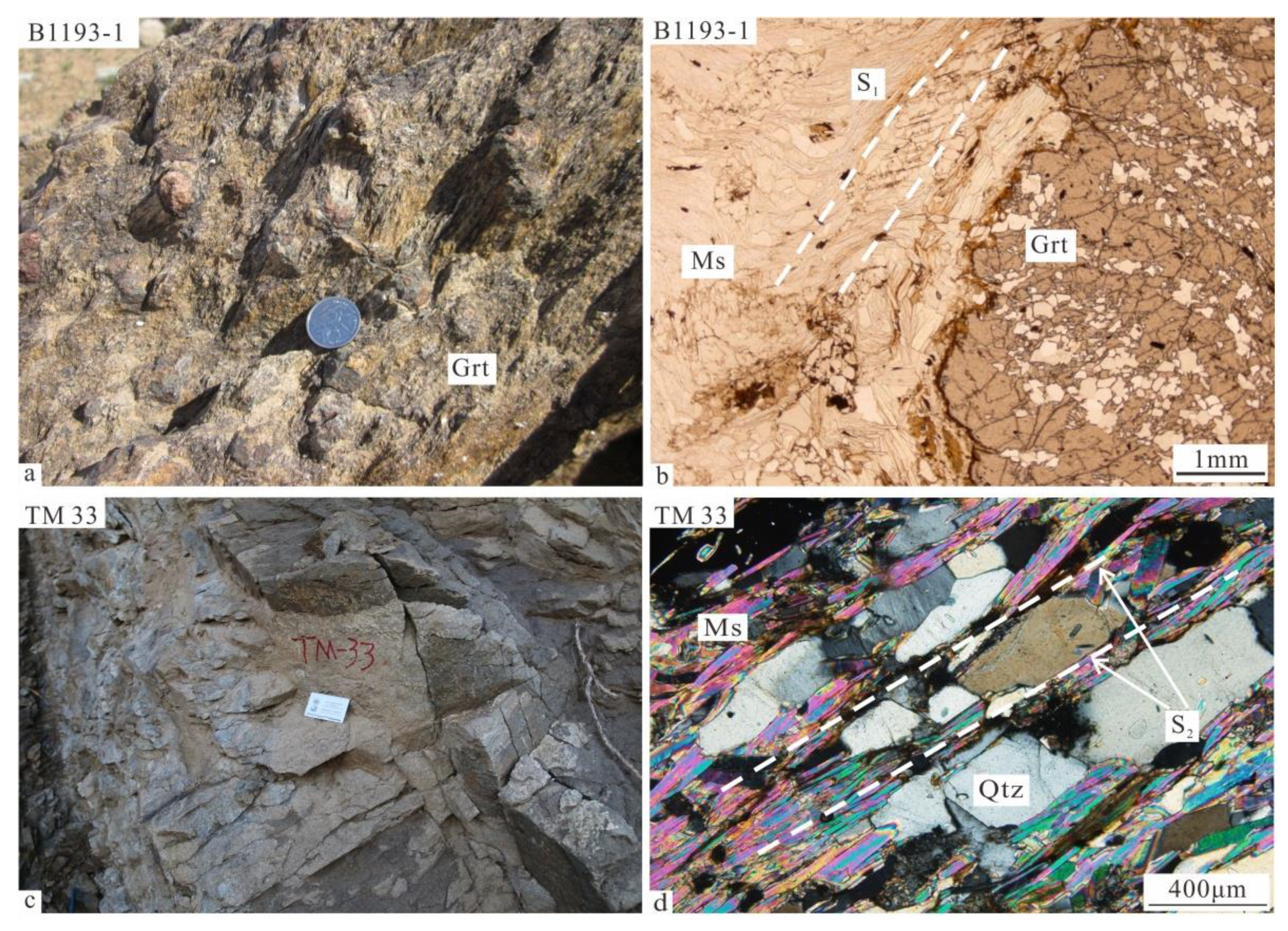
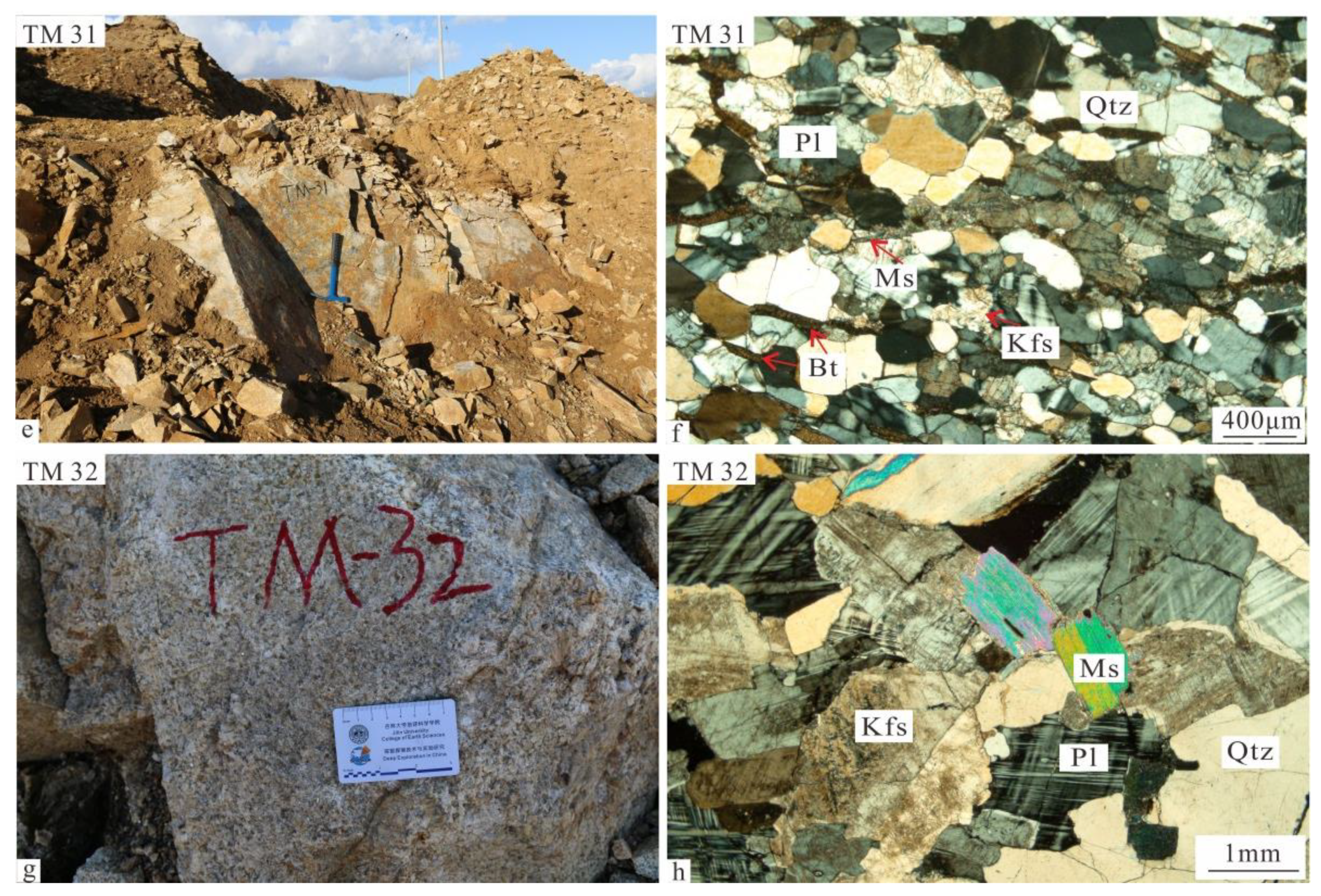

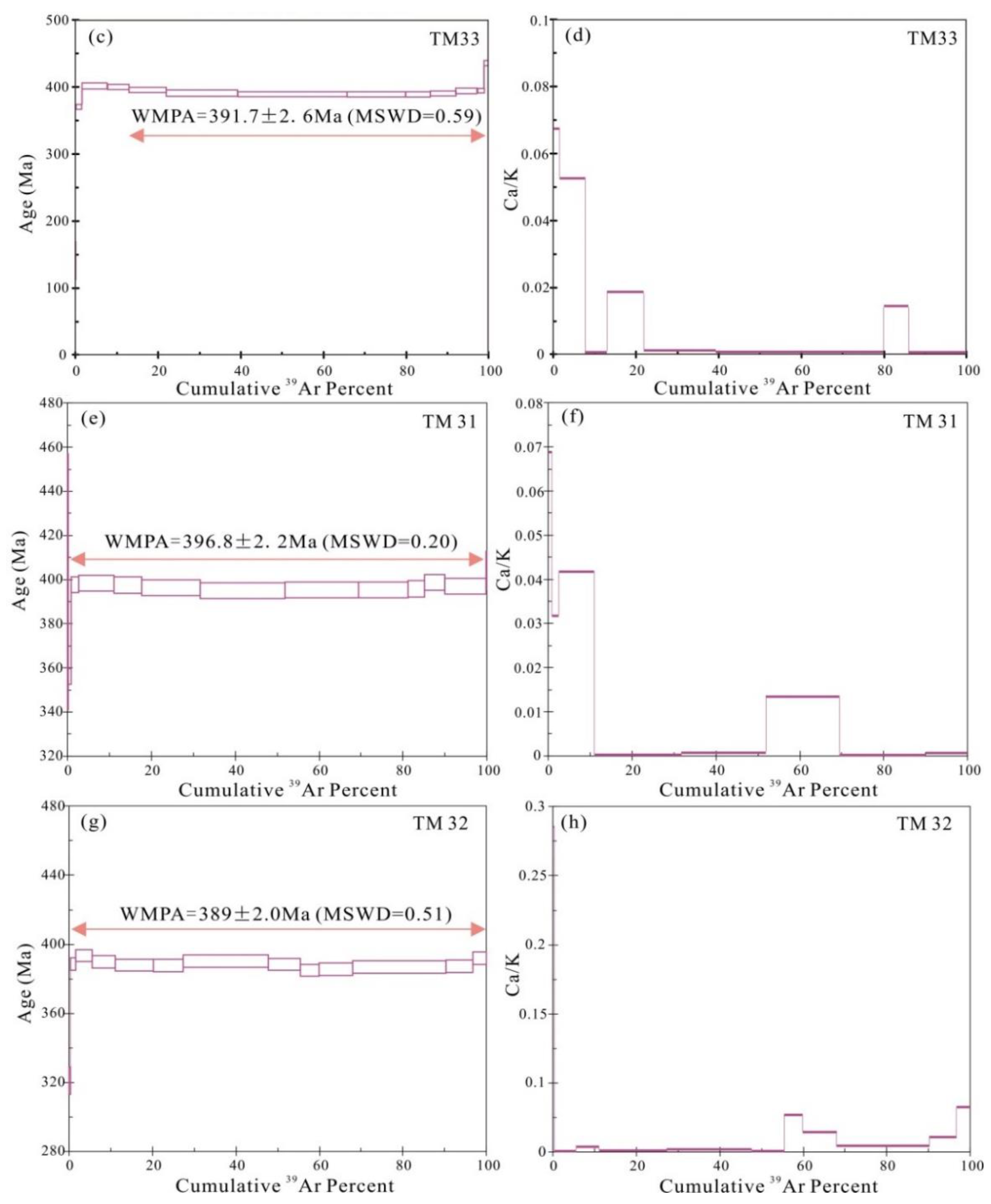


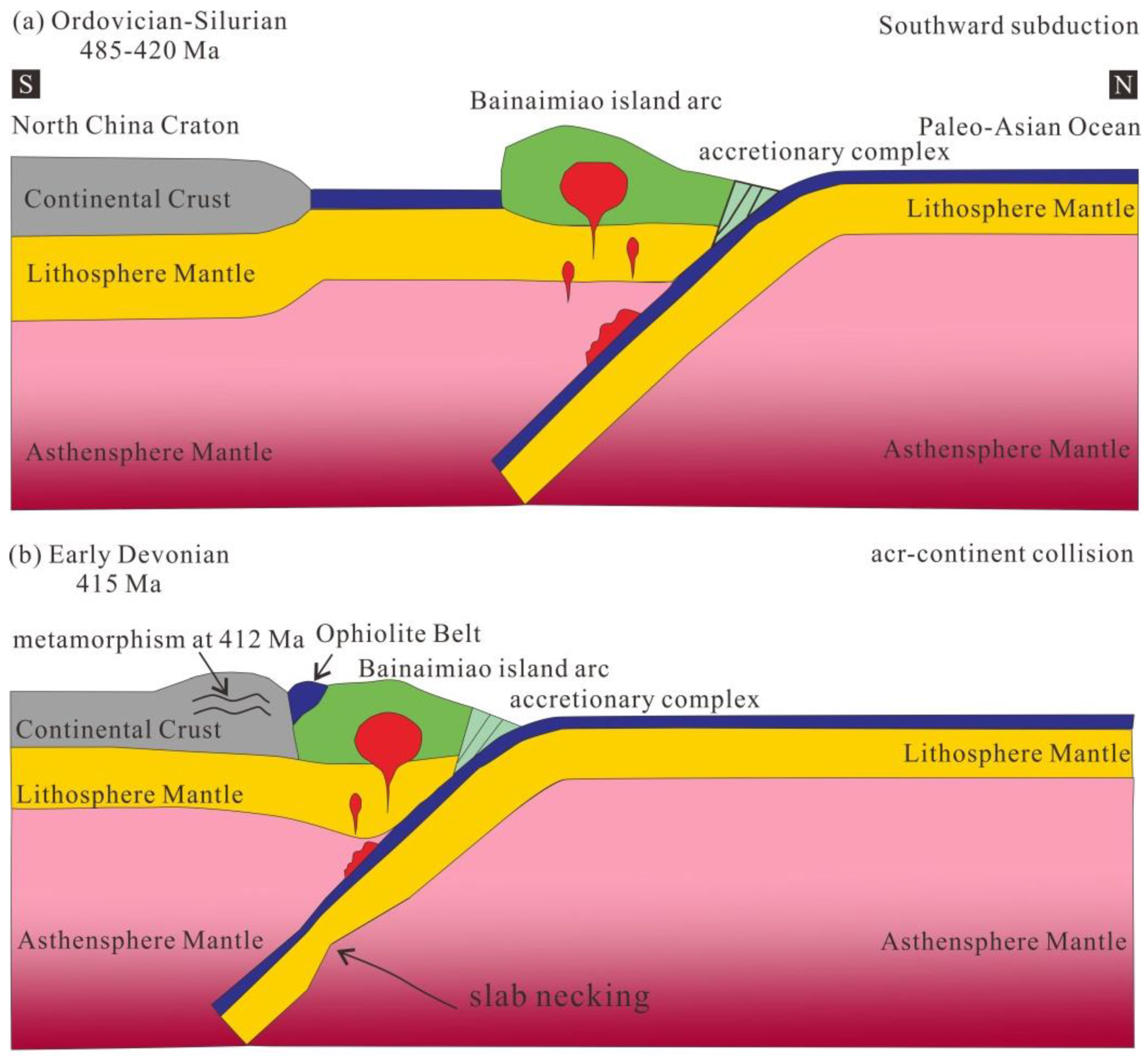
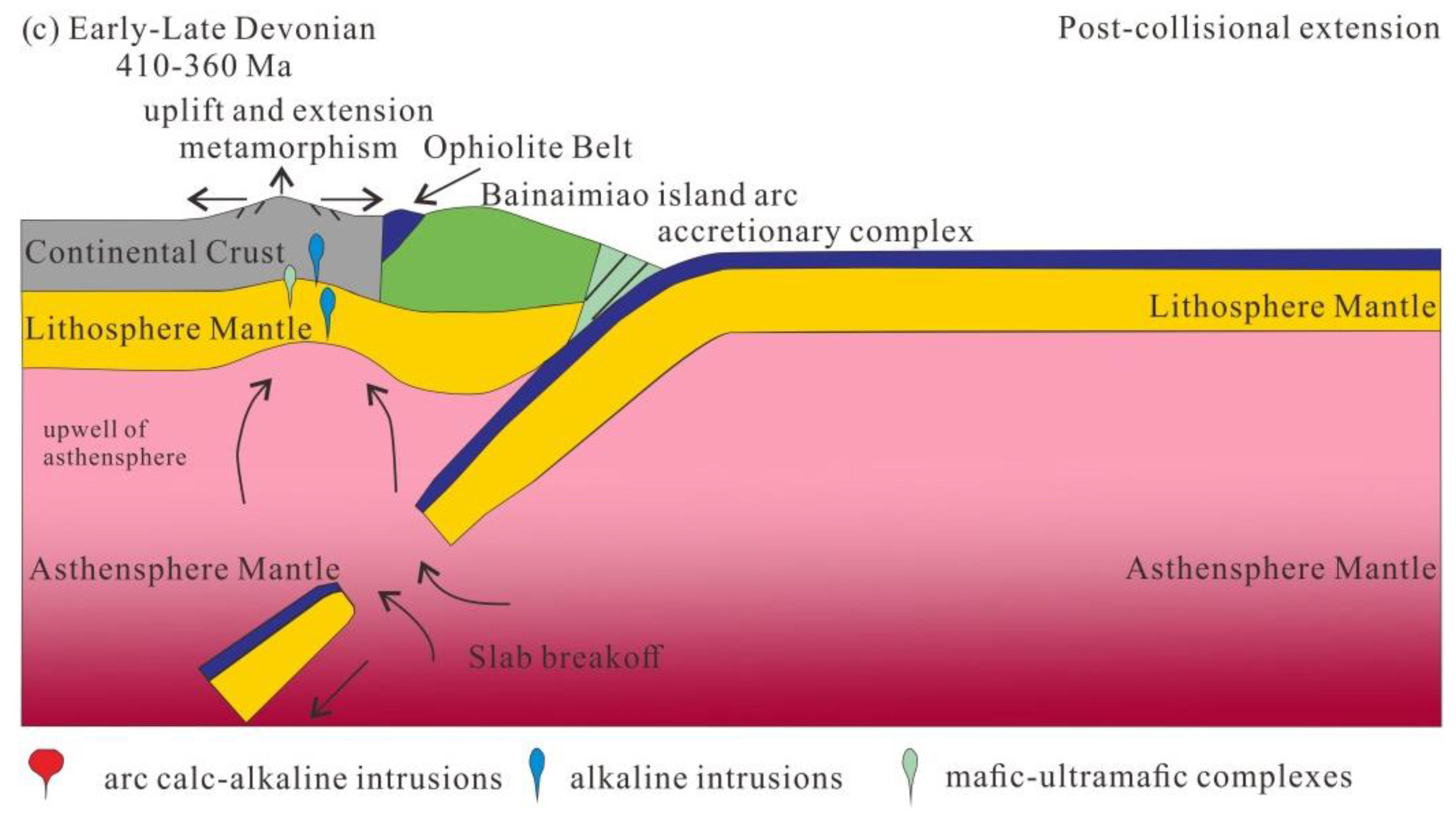
| T (°C) | (40Ar/39Ar)m | (36Ar/39Ar)m | (37Ar/39Ar)m | 40Ar */39Ar | 39Ar (× 10−14 mol) | 39Ar (%) | 40Ar (%) | Age (Ma) | ±1σ (Ma) | Ca/K |
|---|---|---|---|---|---|---|---|---|---|---|
| Sample number = B1193-1; mineral = muscovite; w = 27.04 mg; J = 0.004155 | ||||||||||
| 800 | 68.0003 | 0.0268 | 0.0000 | 60.0721 | 0.18 | 1.27 | 88.34 | 402.0 | 4.3 | 0 |
| 860 | 67.8880 | 0.0195 | 13.1962 | 63.7297 | 0.51 | 4.91 | 92.88 | 423.8 | 4.2 | 22.7502 |
| 910 | 65.1370 | 0.0104 | 0.0000 | 62.0558 | 1.01 | 12.14 | 95.27 | 413.8 | 3.7 | 0 |
| 950 | 64.4862 | 0.0091 | 0.0033 | 61.7934 | 2.55 | 30.28 | 95.82 | 412.3 | 3.7 | 0.0056 |
| 980 | 62.4476 | 0.0035 | 1.1001 | 61.5277 | 2.41 | 47.49 | 98.44 | 410.7 | 3.7 | 1.8965 |
| 1020 | 62.7302 | 0.0052 | 3.4097 | 61.5946 | 1.76 | 60.03 | 97.92 | 411.1 | 3.8 | 5.8727 |
| 1070 | 64.0214 | 0.0106 | 0.0000 | 60.8715 | 0.95 | 66.79 | 95.08 | 406.8 | 3.7 | 0 |
| 1120 | 64.8657 | 0.0129 | 9.9261 | 62.2378 | 0.86 | 72.91 | 95.18 | 414.9 | 4.2 | 17.1125 |
| 1180 | 64.6395 | 0.0103 | 1.7915 | 61.7963 | 1.48 | 83.45 | 95.46 | 412.3 | 3.8 | 3.0886 |
| 1240 | 62.8318 | 0.0036 | 1.4716 | 61.9530 | 1.98 | 97.54 | 98.48 | 413.2 | 3.8 | 2.5371 |
| 1300 | 62.9700 | 0.0121 | 9.9181 | 60.5503 | 0.30 | 99.70 | 95.39 | 405 | 10 | 17.0988 |
| 1400 | 102.9601 | 0.1404 | 42.3699 | 66.7348 | 0.04 | 100.00 | 62.60 | 442 | 28 | 73.0457 |
| Sample number = TM33; mineral = muscovite; w = 12.05 mg; J = 0.004679 | ||||||||||
| 600 | 499.2759 | 1.6175 | 2.2808 | 21.5114 | 0.02 | 0.06 | 4.30 | 173 | 61 | 3.9321 |
| 700 | 74.5002 | 0.0872 | 0.0387 | 48.7319 | 0.51 | 1.61 | 65.41 | 370.5 | 3.5 | 0.0667 |
| 780 | 63.4705 | 0.0341 | 0.0303 | 53.3796 | 2.01 | 7.69 | 84.10 | 402.2 | 3.6 | 0.0522 |
| 810 | 55.8120 | 0.0092 | 0.0000 | 53.1020 | 1.69 | 12.84 | 95.14 | 400.3 | 3.6 | 0 |
| 850 | 54.8928 | 0.0083 | 0.0114 | 52.4227 | 3.01 | 21.97 | 95.50 | 395.7 | 3.6 | 0.0196 |
| 900 | 54.3272 | 0.0088 | 0.0056 | 51.7154 | 5.72 | 39.33 | 95.19 | 390.9 | 3.5 | 0.0097 |
| 940 | 52.6231 | 0.0039 | 0.0000 | 51.4546 | 8.68 | 65.66 | 97.78 | 389.2 | 3.5 | 0 |
| 980 | 53.4156 | 0.0064 | 0.0000 | 51.5051 | 4.70 | 79.93 | 96.42 | 389.5 | 3.5 | 0 |
| 1020 | 54.8943 | 0.0115 | 0.0091 | 51.4863 | 1.92 | 85.75 | 93.79 | 389.4 | 3.5 | 0.0157 |
| 1080 | 54.4019 | 0.0093 | 0.0000 | 51.6558 | 2.06 | 92.00 | 94.95 | 390.5 | 3.5 | 0 |
| 1140 | 53.2768 | 0.0036 | 0.0000 | 52.2071 | 1.74 | 97.28 | 97.99 | 394.3 | 3.6 | 0 |
| 1240 | 53.9998 | 0.0057 | 0.0000 | 52.3075 | 0.48 | 98.75 | 96.87 | 395.0 | 3.6 | 0 |
| 1400 | 63.1326 | 0.0140 | 0.0000 | 58.9888 | 0.41 | 100.00 | 93.44 | 439.7 | 4.0 | 0 |
| Sample number = TM31; mineral = muscovite; w = 13.12 mg; J = 0.004560 | ||||||||||
| 600 | 2062.9160 | 6.7973 | 0.0000 | 54.2982 | 0.01 | 0.04 | 2.63 | 399 | 58 | 0 |
| 700 | 93.3615 | 0.1540 | 0.0396 | 47.8497 | 0.26 | 0.89 | 51.25 | 356.1 | 3.6 | 0.0682 |
| 760 | 70.1123 | 0.0543 | 0.0188 | 54.0787 | 0.51 | 2.57 | 77.13 | 397.6 | 3.6 | 0.0323 |
| 810 | 59.7989 | 0.0190 | 0.0241 | 54.1764 | 2.56 | 11.06 | 90.60 | 398.3 | 3.6 | 0.0415 |
| 850 | 56.2654 | 0.0075 | 0.0000 | 54.0551 | 1.97 | 17.59 | 96.07 | 397.5 | 3.6 | 0 |
| 900 | 54.8444 | 0.0032 | 0.0000 | 53.8864 | 4.21 | 31.56 | 98.25 | 396.4 | 3.6 | 0 |
| 940 | 54.2762 | 0.0020 | 0.0010 | 53.6698 | 6.13 | 51.88 | 98.89 | 394.9 | 3.5 | 0.0017 |
| 970 | 54.5972 | 0.0029 | 0.0083 | 53.7296 | 5.27 | 69.36 | 98.41 | 395.3 | 3.6 | 0.0143 |
| 1000 | 54.8380 | 0.0037 | 0.0000 | 53.7469 | 3.56 | 81.16 | 98.01 | 395.4 | 3.6 | 0 |
| 1040 | 54.8218 | 0.0035 | 0.0000 | 53.7945 | 1.21 | 85.19 | 98.13 | 395.8 | 3.6 | 0 |
| 1140 | 54.9719 | 0.0024 | 0.0000 | 54.2560 | 1.42 | 89.90 | 98.70 | 398.8 | 3.6 | 0 |
| 1200 | 55.4690 | 0.0050 | 0.0011 | 53.9751 | 2.96 | 99.73 | 97.31 | 397.0 | 3.6 | 0.0018 |
| 1400 | 69.0075 | 0.0472 | 0.0000 | 55.0600 | 0.82 | 100.00 | 79.79 | 404.1 | 8.7 | 0 |
| Sample number = TM32; mineral = muscovite; w = 14.20 mg; J = 0.004734 | ||||||||||
| 680 | 336.9141 | 1.0007 | 0.1655 | 41.2319 | 0.13 | 0.30 | 12.24 | 321.0 | 7.9 | 0.2854 |
| 740 | 108.9103 | 0.1967 | 0.0000 | 50.7659 | 0.49 | 1.47 | 46.61 | 388.5 | 3.7 | 0 |
| 800 | 77.8633 | 0.0892 | 0.0000 | 51.4847 | 1.70 | 5.51 | 66.13 | 393.5 | 3.5 | 0 |
| 840 | 54.9206 | 0.0134 | 0.0098 | 50.9690 | 2.29 | 10.98 | 92.80 | 389.9 | 3.5 | 0.0169 |
| 880 | 51.4334 | 0.0026 | 0.0000 | 50.6671 | 3.83 | 20.12 | 98.51 | 387.9 | 3.5 | 0 |
| 920 | 50.8614 | 0.0008 | 0.0000 | 50.6346 | 2.98 | 27.23 | 99.55 | 387.6 | 3.5 | 0 |
| 960 | 51.2433 | 0.0008 | 0.0027 | 51.0053 | 8.62 | 47.79 | 99.54 | 390.2 | 3.5 | 0.0046 |
| 990 | 51.0594 | 0.0011 | 0.0000 | 50.7307 | 3.18 | 55.38 | 99.36 | 388.3 | 3.5 | 0 |
| 1020 | 51.0247 | 0.0026 | 0.0507 | 50.2527 | 1.90 | 59.92 | 98.48 | 385.0 | 3.5 | 0.053 |
| 1060 | 50.9623 | 0.0021 | 0.0198 | 50.3257 | 3.34 | 67.88 | 98.75 | 385.5 | 3.5 | 0.0341 |
| 1120 | 50.8751 | 0.0012 | 0.0063 | 50.5214 | 9.38 | 90.25 | 99.30 | 386.9 | 3.5 | 0.0109 |
| 1200 | 51.0611 | 0.0017 | 0.0188 | 50.5663 | 2.72 | 96.73 | 99.03 | 387.2 | 3.5 | 0.0325 |
| 1400 | 53.5723 | 0.0078 | 0.0387 | 51.2617 | 1.37 | 100.00 | 95.68 | 391.9 | 3.5 | 0.0666 |
© 2020 by the authors. Licensee MDPI, Basel, Switzerland. This article is an open access article distributed under the terms and conditions of the Creative Commons Attribution (CC BY) license (http://creativecommons.org/licenses/by/4.0/).
Share and Cite
Li, C.; Li, S.; Liu, Z.; Xu, Z.; Dong, X.; Shi, Q.; Wang, S.; Feng, F. Early-Late Devonian Post-Collision Extension Due to Slab Breakoff Regime along the Northern Margin of North China Craton: Implications from Muscovite 40Ar-39Ar Dating. Minerals 2020, 10, 580. https://doi.org/10.3390/min10070580
Li C, Li S, Liu Z, Xu Z, Dong X, Shi Q, Wang S, Feng F. Early-Late Devonian Post-Collision Extension Due to Slab Breakoff Regime along the Northern Margin of North China Craton: Implications from Muscovite 40Ar-39Ar Dating. Minerals. 2020; 10(7):580. https://doi.org/10.3390/min10070580
Chicago/Turabian StyleLi, Changhai, Shichao Li, Zhenghong Liu, Zhongyuan Xu, Xiaojie Dong, Qiang Shi, Shijie Wang, and Fan Feng. 2020. "Early-Late Devonian Post-Collision Extension Due to Slab Breakoff Regime along the Northern Margin of North China Craton: Implications from Muscovite 40Ar-39Ar Dating" Minerals 10, no. 7: 580. https://doi.org/10.3390/min10070580
APA StyleLi, C., Li, S., Liu, Z., Xu, Z., Dong, X., Shi, Q., Wang, S., & Feng, F. (2020). Early-Late Devonian Post-Collision Extension Due to Slab Breakoff Regime along the Northern Margin of North China Craton: Implications from Muscovite 40Ar-39Ar Dating. Minerals, 10(7), 580. https://doi.org/10.3390/min10070580




